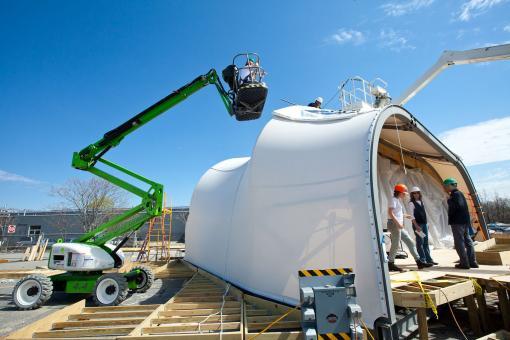
Building the house first in Providence allowed the team to find and fix any problems — like stretching the textile roof to fit the steel and wood frame. The entire building will soon be on a ship bound for France.
Credit: David O’Connor
PROVIDENCE, R.I. [Brown University] — Techstyle Haus is about to set sail.
Stateside construction wrapped up last week on the Brown/RISD/Erfurt entry in the 2014 Solar Decathlon Europe. Over the last three months, students erected the house's wooden and steel structural supports, attached the signature textile shell, and added the solar panels that will provide all the power the house needs.
Now it's time to tear it all down, box it up, and put it on a boat. Five shipping containers, the first two of which depart Friday, will carry Techstyle Haus across the Atlantic. The containers will eventually make their way to Versailles, France, site of this year's Solar Decathlon. The international competition challenges 20 collegiate teams to build the most innovative, efficient and livable solar home.
The construction phase in Providence was a dry run for the final assembly at Versailles. Each team has 10 days to assemble their homes at the competition site before judging opens formally on June 28. By building in Providence first, the Techstyle Haus team had a chance to work out the inevitable kinks that arise in building a one-of-a-kind home.
"Every week we saw something that we wanted to approach differently in practice than how we had planned when designing, which has allowed us to find a way to build it quickly and efficiently," said Gareth Rose, a sophomore in engineering and one of the team's project managers. "The whole process has been such an amazing learning process for everyone involved."
One of the students' key tasks was stretching out the house's textile shell, which is made of a fiberglass material called Sheerfill.
"Like a quilt that's too small to cover your neck and your feet at the same time, the Sheerfill membrane was initially too small to cover the North and South faces at the same time," Stein said. "The team loosened the skin along the East and West of the perimeter and stretched the membrane along the North and South. After a few days the skin had extended enough for it to be permanently attached to the outermost ribs. Now that the skin has been broken in, the team expects a much easier time in Versailles."
The 20 entries in the Solar Decathlon competition will be judged in each of 10 different categories. The Techstyle Haus team has set their sights on winning the category that focuses on innovation in design — something Techstyle Haus has all over it. Sheerfill, often used for the roofs of stadiums and airplane hangers, has never been used before in residential construction. The textiles are layered in a way that maximizes their thermal properties, making it possible to reach the standard for a passive house — one that uses 90 percent less energy for heating and cooling than a standard house.
"With this first-ever textile passive fabric house, we're not only going into the competition with a goal to accomplish — win the Innovation category – beyond that, we are hoping to change the way people think about building materials and inspire them to push the limits of architecture, design and engineering," said Kim Dupont-Madinier, an architecture student at RISD. "We are really pleased with how the complete house turned out – even better than we could have imagined. All of our ideas, and then some, have come to fruition and the visual outcome is beautiful. By experimenting on this scale, we've now come to understand how the different fabrics are performing within the house by applying them holistically."
Student team members will start making their way to France at the end of May, when parts of the house start to arrive. And while they're excited that the competition they've work toward for nearly two years is close at hand, they're very aware that much work still lies ahead.
"It's pretty amazing to be able to walk around and work inside the house we've been thinking up for so long," Rose said. "Having members of the community, special guests like Presidents Somerson and Paxson and Senator Whitehouse, and especially our friends and family tour the house recently has been surreal for the whole team. We're all very focused on finishing the build right now, but every once in a while someone steps back and reminds us all how amazing it will be once it's finally up in Versailles."
- by Kevin Stacey